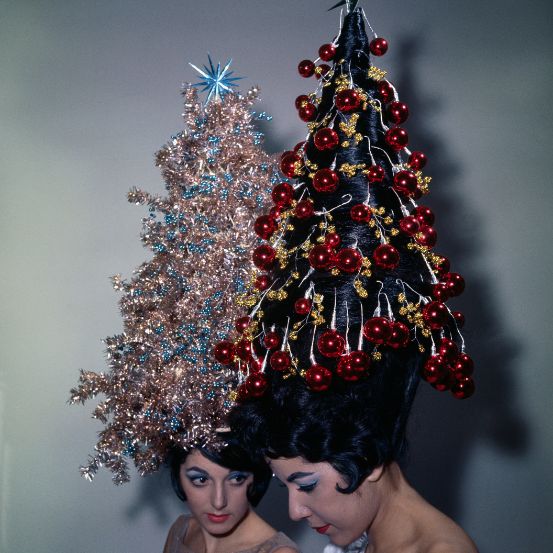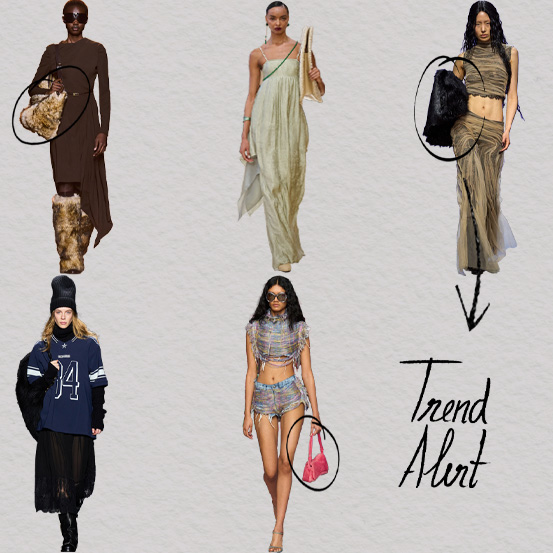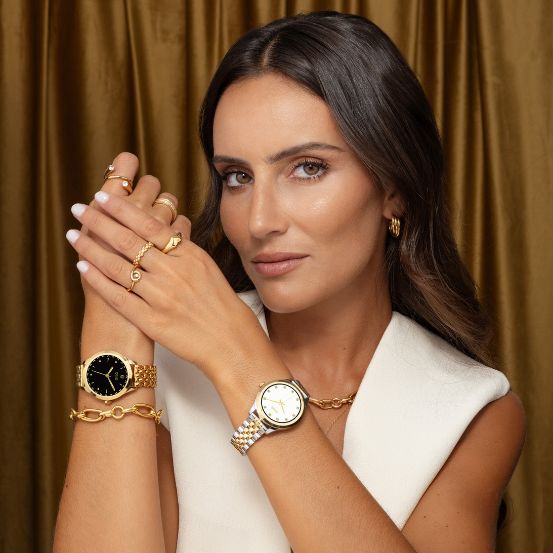Predicting the future of Beauty is simple. You take the nostalgia of a more-than-perfect past and add the verbs of the present tense. The truth is that where we are says a lot about where we come from - but it says even more about where we are going. And if the next twenty years bring as much to the cosmetics industry as the last two decades have, then it's worth staying to follow the journey.
Predicting the future of Beauty is simple. You take the nostalgia of a more-than-perfect past and add the verbs of the present tense. The truth is that where we are says a lot about where we come from - but it says even more about where we are going. And if the next twenty years bring as much to the cosmetics industry as the last two decades have, then it's worth staying to follow the journey.
The year was 2002. The second Harry Potter movie was breaking box office records and Avril Lavigne had just released her debut album. Other than that, it was not a very happy year for pop culture. Justin Timberlake and Britney Spears made the end of their relationship official, and Ben Affleck was voted the sexiest man in the world by People magazine. Water under the bridge, shall we say. In the field of Beauty trends, small traces of the change of millennium were still visible. Christina Aguilera blessed every red carpet with her shining lips, and Britney Spears made history alongside Michael Jackson at the 2002 MTV Video Music Awards. There was the occasional haunting of the very bright white eye shadow, sometimes present in the inner corner of the eye (Kim Kardashian, we're thinking of you), just as there were those who preferred a more colorful eyelid, painted in shades of blue or violet. It was 2002, and that is a justification in itself. There was no talk of sustainability or inclusion, but there was talk of Paris Hilton's look on her 21st birthday. And this is neither better nor worse, it’s a sign of the times. A time that has changed, just as the desires of those who inhabit it. What have twenty years done to Beauty? What has changed? And what has remained intact? But, above all, where are we going? There is a beautiful new world to discover.
In twenty years, people have changed. Because people change, it is natural, but the change that has taken place over the last two decades has brought something that the cosmetics industry had not yet known: a new power dynamic. “If we look back at the Beauty industry twenty, thirty, fifty years ago, the makeup companies had all the power – and magazines too. They would sit in their office, and they would be like: ‘Ok, we’re going to tell everybody else what’s going on.’” Jeanine Recckio knows what she's talking about. The cosmetics tycoon has been working for decades with the most powerful brands in the industry, from Estée Lauder to Ralph Lauren, without forgetting the retailer Sephora, and the giant L'Oréal. They called her the "Beauty futurologist" and these words came true when she created the trend forecasting agency Mirror Mirror. When Vogue Portugal spoke to Recckio on the phone, there was no hint of hesitation in her voice: “The tables have turned. It is now the consumer that carries all the power. Thanks to social media, they have become the fashion editor, the beauty editor, and the beauty police. [They do] Everything from judging products, trying products and, very importantly, dissecting the ingredient listing.” Olivia Houghton, deputy creative foresight editor at the strategic foresight consultancy The Future Laboratory corroborates this change, so significant to the structure of the industry: “Consumers were once only really engaged with brands via a handful of external touchpoints, but now they’re turning organizations inside-out and tearing down the branded façade. This intimate relationship is transforming how brands communicate with audiences – be it through packaging, social media, or web platforms.” If brands want to win the consumer's trust, transparency is an indispensable component of their communicative strategy. Beauty is no longer just an aesthetic issue; there are higher values at stake.
In twenty years, the planet has changed. And not for the better, as we know all too well. Few were talking about climate change at the turn of the millennium, yet two decades later, there is no greater buzzword than sustainability. Clearly, environmental concerns have had a major impact on the cosmetics industry's priorities, largely driven by the ultimate catalyst of the industry - the consumer. But beyond packaging produced from recycled plastic or manifestos with empty promises, the present (and future) of sustainability in beauty lies with the ingredients. Jeanine Recckio says that the cosmetics industry is today “highly regulated”, with, together with a “consumer so smart” will culminate in a set of labeling laws that we already see in the food sector, for example. “it’s already happening in some countries, like France… You go [to the supermarket] and you see a piece of meat. You now want to track and trace where did that meat come from and [the label] will say ‘It came from Howard Farms, Main Street, the farmer’s name is Mr. Jones and the cow’s name was Bessy.’ (…) The same thing is going to be happening in the future with Beauty. Let’s say there’s a face mask and there’s pomegranate in it. Consumers are going to start demanding where did the pomegranate come from – not just what country but what farm. It’s very interesting to watch as far as sustainability, ingredient listings and regulations.” Olivia Houghton knows that “education and transparency have – and always will be – a key focus for brands and business.” However, the deputy creative foresight editor believes we will continue to see a steep growth of what she calls "sci-fluence." “As the world adjusts to life with Covid-19 as a constant presence, people have become increasingly trusting of science and its related experts and research bodies. (…) As we continue to see this rise in hard data, science and expertise, data analysis will begin to shape experiences and product development,” Houghton explains. In other words, if the last twenty years have been about symbolic changes in the search for a more environmentally friendly industry - the introduction of refillable packaging and more natural formulas were examples of that - the next years will have to be characterized by real revolutions shaped by scientific knowledge and guided by the limits of nature. But sustainability is not the only part of the cosmetics industry that needs a major shake-up.
In twenty years, the way we see diversity has changed. It would be impossible to describe the changes in the Beauty industry over the past two decades without talking about inclusion. In fact, two decades might be too long a period for the issue raised here - after all, it was only in 2017 that Fenty Beauty took the industry by storm with its Beauty For All campaign and the launch of a foundation with 40 skin tone options (there are now 59). But in five years, much has been accomplished and inclusion has become an industry priority. A priority? “It’s not only a priority, it’s mandatory,” Jeanine Recckio says as soon as the topic comes up. “If you come out with a foundation now at Sephora and you do not have at least thirty shades, you’re considered to be a racist.” But it wasn't always like this. During her career, Recckio remembers encountering various obstacles whenever she proposed an extension of the color range of Beauty products. They said “we don’t need that many shades, it’s very expensive, it takes up too much room. And I would say: ‘Trust me, this is going to change.’” And it has changed. It has changed so much that the founder of Mirror Mirror believes it’s “getting a little out of control. I don’t really think we need forty shades of foundation. At some point you don’t even know which one to pick.” However, Jeanine Recckio is confident that the demand for greater diversity and inclusion in the cosmetics sector “it’s not going to go away” and that is why the industry is looking for alternatives to the current practices that, even though are good for consumers, are also becoming real logistical puzzles for companies. This is where technology has a role to play. “In foundations, there will be one shade and it will be invisible. You’re going to put it on your face, and you’re going to touch your phone and go on an app. [That app] will read your skin tone and the foundation will change to that color,” shares Jeanine Recckio about the future of diversity in Beauty. It's a tech world, and the cosmetics industry has been feeling it for a long time.
In twenty years, technology has changed. And it has brought changes with it. There are too many to ever list in so few pages. But if there is one benefit that deserves to be highlighted, it has to be the quality of Beauty products. “I have a vintage collection of makeup. When you look back to some of those formulas, powders… It’s crazy how different the formulas are today. We’re making powders differently,” says Jeanine Recckio. “If you look at the pigments and powders under a microscope, they’re wow. They’re not flat, they’re multidimensional. (…) “[There’s] a new light-reflective technology, different polymers. From a real scientific point of view, when you look under a microscope, makeup has come a really long way.” New formulas have brought new finishes, whether integrated into the product itself or achieved through new tools that did not exist twenty years ago. Recckio believes that the resurgence of Beauty brushes and sponges has been an important part of the last decades of the cosmetic industry, even if it sometimes goes unnoticed. With these tools, "[the face] a lot less like makeup, it looks a lot more real, a lot more sensorial, very camera-friendly, because we’re the most photographed genre ever and that’s where makeup, hair, Beauty comes into play.” Reinventing formulas and creating innovative tools is what technology has been doing recently, but in the future it is not expected to stop there. “Have you been seeing the new Kardashians show?” asks Jeanine Recckio in between laughs. “Yes,” I answer, a bit confused by the question. “They [the Kardashians] are using high-tech new cameras. Oprah Winfrey started it years ago – and movies are doing it too – where there’s automated filtering and light filtering mixed in so what you’re seeing is now what you’re really seeing, do you get it?” I do get it. As an avid social media user, I get it too well. And the truth is, according to Recckio, a filtered future is what awaits us at the blink of an eye. “We’ll be wearing contact lenses, so you can go out and program your face so if someone looks at you, you have an automatic filter. (…) You’re going to say ‘If this person passes by me, I want to have filter number 224 on.’” Quo vadis, good sense?
In twenty years, the Beauty industry has changed. A lot has happened in two decades, be it on a political, economic, social or cultural level, and all these occurrences have had an impact, direct or indirect, on the way this industry orientates itself and interacts with its audience. “It’s really about creating products that respond in real-time to consumers’ needs and wants. (…) Individuals’ identities are constantly in flux, so brands need to keep up or they’ll get left behind,” advises Olivia Houghton. And that flux has never been more visible than in the last two years. Nothing shapes an identity like living through a pandemic, a war, and an economic crisis. And we can already see the first consequences of this. For example, for the first time in the history of the cosmetics industry, sales of skincare products have surpassed sales of makeup products. As Jeanine Recckio explains, “skincare has surged because it’s healthcare. Our skin is over 70% of our body, it’s our largest organ. (…) If your skin isn’t healthy, you die. If your pores are not letting out toxins, you die. If you don’t wear makeup, you’re not going to die.” The trend forecaster believes that we are facing a fusion of Beauty with the medical field. On the more aesthetic side, we have seen the growth of fields such as “plastic surgery, dermatology, and cosmetic dermatology.” But when we get to the core of this fusion - health - the boundaries between medicine and cosmetics blur. Recckio gives the example of blood or hair testing, where a health professional “takes a snip of your hair and, from that hair test, it can tell you so much about your body, your skin, your body shape.” Is it a medical or cosmetic procedure? It is hard to say. Perhaps this is why Jeanine Recckio believes that in a few years Beauty will not be divided into such rigid categories: “It's not just makeup, skincare… It’s self-care. It’s looking at your hair snippet, your vitamins, your minerals and then talking about your Beauty needs, whether it’s makeup, skincare, fragrance, or whatever.” It is no longer a guessing, trial-error game, it is a matter of science. “Skin is skin. Blood is blood. Hair is hair. It can be changed and altered but it’s still, from a cell structure point of view, it’s still a human cell. (…) We’re starting to see this wonderful inclusion, from formulas, usage, and mindset. It’s very exciting.” Beauty in 2022 is very exciting indeed. Full of ups and downs, progress and setbacks, and tremendous opportunities to pursue. Where will we be in 2042? We don't know. It is precisely this mystery that keeps (and will keep) the cosmetics industry alive decade after decade, twenty, forty, or a hundred years down the road.
Translated from the original on The 20th anniversary issue, published November 2022.Full story and credits in the print version.
Relacionados




.jpg)

.jpg)

